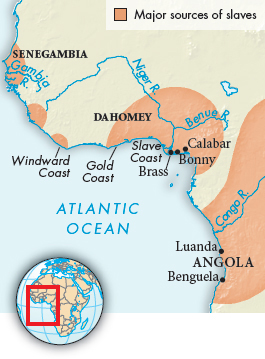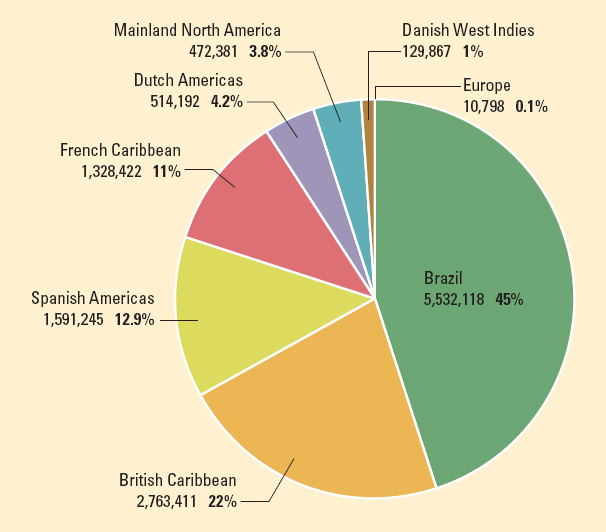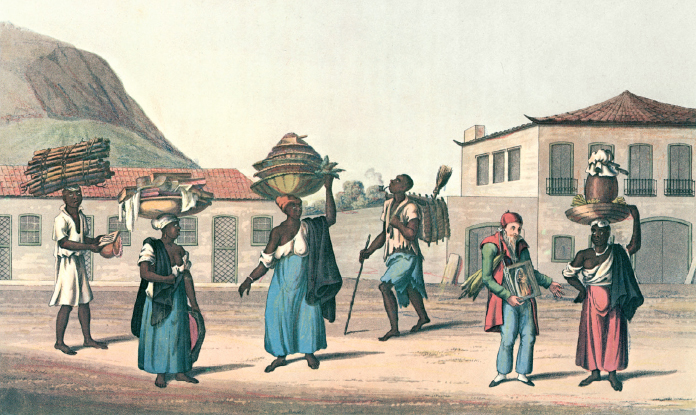Understanding World Societies:
Printed Page 598
The Transatlantic Slave Trade
Although the trade in African people was a worldwide phenomenon, the transatlantic slave trade involved the largest number of enslaved Africans. This forced migration of millions of human beings, extending from the early sixteenth to the late nineteenth centuries, represents one of the most inhumane, unjust, and shameful tragedies in human history. It also immediately provokes a troubling question: why, in the seventeenth and eighteenth centuries, did enslavement in the Americas become exclusively African?
European settlers first enslaved indigenous peoples, the Amerindians, to mine the silver and gold discovered in the New World (see “The Birth of the Global Economy” in Chapter 16). When they proved ill suited to the harsh rigors of mining, the Spaniards brought in Africans.
Why did the Spaniards turn to Africa to solve their labor problem? One theory holds that in the Muslim and Arab worlds by the tenth century, an association had developed between blackness and menial slavery. Although the great majority of enslaved persons in the Islamic world were white, a racial element existed in Muslim perceptions: not all slaves were black, but blacks were identified with slavery. In Europe, after the arrival of tens of thousands of sub-
Another important question relating to the African slave trade is this: why were African peoples enslaved in a period when serfdom was declining in western Europe, and when land was so widely available and much of the African continent had a labor shortage? The answer seems to lie in a technical problem related to African agriculture. African conditions were unsuitable for plowing with draft animals, and most work had to be done by hand with the hoe. Productivity, therefore, was low. Thus, in precolonial Africa the individual’s agricultural productivity was low, so his or her economic value to society was less than the economic value of a European peasant in Europe. Enslaved persons in the Americas were more productive than free producers in Africa. And European slave dealers were very willing to pay a price higher than the value of an African’s productivity in Africa.
The incidence of disease in the Americas also helps explain African enslavement. Smallpox took a terrible toll on Native Americans, and between 30 and 50 percent of Europeans exposed to malaria succumbed to that sickness. Africans had developed some immunity to both diseases, and in the Americas they experienced the lowest mortality rate of any people, making them, ironically, the most suitable workers for the environment.

Portuguese colonization of Brazil began in the early 1530s, and in 1551 the Portuguese founded a sugar colony at Bahia. Between 1551 and 1575, before the North American slave traffic began, the Portuguese delivered more African slaves to Brazil than ever reached British North America (Figure 20.1). Portugal essentially monopolized the slave trade until 1600 and continued to play a significant role in the seventeenth century, though the trade was increasingly taken over by the Dutch, French, and English. From 1690 until the British House of Commons abolished the slave trade in 1807, England was the leading carrier of African slaves.

Brazil was the single largest importer of African slaves from 1501 to 1866. But when taken cumulatively, the British, French, Dutch, and Danish colonies of the Caribbean rivaled the much larger colony of Brazil for numbers of slaves imported from Africa. (Source: Data from Emory University. “Assessing the Slave Trade: Estimates,” in Voyages: The Trans-
Population density and supply conditions along the West African coast and the sailing time to New World markets determined the sources of slaves. As the demand for slaves rose, slavers moved down the West African coast from Senegambia to the more densely populated hinterlands of the Bight of Benin and the Bight of Biafra. The abundant supply of Africans to enslave in Angola, the region south of the Congo River, and the quick passage from Angola to Brazil and the Caribbean established that region as the major coast for Portuguese slavers.
Transatlantic wind patterns partly determined exchange routes. Shippers naturally preferred the swiftest crossing — that is, from the African port nearest the latitude of the intended American destination. Thus Portuguese shippers carried their cargoes from Angola to Brazil, and British merchants sailed from the Bight of Benin to the Caribbean. The great majority of enslaved Africans were intended for the sugar and coffee plantations extending from the Caribbean islands to Brazil. Angola produced 26 percent of all African slaves and 70 percent of all Portuguese slaves. Trading networks extending deep into the interior culminated at two major ports on the Angolan coast, Luanda and Benguela. The Portuguese acquired a few slaves through warfare but secured the vast majority through trade with African dealers. Whites did not participate in the inland markets, which were run solely by Africans.
Almost all Portuguese shipments went to satisfy the virtually insatiable Brazilian demand for slaves. The so-
Olaudah Equiano (see “Individuals in Society: Olaudah Equiano”) describes the experience of his voyage as a captured slave from Benin to Barbados in the Caribbean:
The stench of the hold while we were on the coast was so intolerably loathsome that it was dangerous to remain there for any time, and some of us had been permitted to stay on the deck for the fresh air; but now that the whole ship’s cargo were confined together it became absolutely pestilential. The closeness of the place and the heat of the climate, added to the number in the ship, which was so crowded that each had scarcely room to turn himself, almost suffocated us. This produced copious perspirations, so that the air soon became unfit for respiration from a variety of loathsome smells, and brought on a sickness among the slaves, of which many died. . . . This wretched situation was again aggravated by the galling of the chains, now become insupportable, and the filth of the necessary tubs [of human waste], into which the children often fell and were almost suffocated. The shrieks of the women and the groans of the dying rendered the whole a scene of horror almost inconceivable.8
Although the demand was great, Portuguese merchants in Angola and Brazil sought to maintain only a steady trickle of slaves from the African interior to Luanda and across the ocean to Bahia and Rio de Janeiro: a flood of slaves would have depressed the American market. Planters and mine operators from the provinces traveled to Rio to buy slaves. Between 1795 and 1808 approximately 10,000 Angolans per year stood in the Rio slave market. In 1810 the figure rose to 18,000; in 1828 it reached 32,000.9
The English ports of London, Bristol, and particularly Liverpool dominated the British slave trade. In the eighteenth century Liverpool was the world’s greatest slave-
Slaving ships from Bristol plied back and forth along the Gold Coast, the Bight of Benin, Bonny, and Calabar looking for African traders who were willing to supply them with slaves. Liverpool’s ships drew enslaved people from Gambia, the Windward Coast, and the Gold Coast. British ships carried textiles, gunpowder and flint, beer and spirits, British and Irish linens, and woolen cloth to Africa. A collection of goods was grouped together into what was called the sorting. An English sorting might include bolts of cloth, firearms, alcohol, tobacco, and hardware; this batch of goods was traded for an enslaved individual or a quantity of gold, ivory, or dyewood.10

A British army officer sketched this early-
European traders had two systems for exchange. First, especially on the Gold Coast, they established factory-
The shore method of buying slaves allowed the ship to move easily from market to market. The final prices of those enslaved depended on their ethnic origin, their availability when the shipper arrived, and their physical health when offered for sale in the West Indies or the North or South American colonies.
The supply of slaves for the foreign market was controlled by a small, wealthy African merchant class or by a state monopoly. By contemporary standards, slave raiding was a costly operation, and only black African entrepreneurs with sizable capital and labor could afford to finance and direct raiding drives.
The transatlantic slave trade that the British, as well as the Dutch, Portuguese, French, Americans, and others, participated in was part of a much larger trading network that is known as the triangle trade. European merchants sailed to Africa on the first leg of the voyage to trade European manufactured goods for enslaved Africans. When they had filled their ships’ holds with enslaved peoples, they headed across the Atlantic on the second leg of the voyage, the Middle Passage. When they reached the Americas, the merchants unloaded and sold their human cargoes and used the profits to purchase raw materials — such as cotton, sugar, and indigo — that they then transported back to Europe, completing the third leg of the commercial triangle.
The Triangle Trade:
- Africa: Europeans trade manufactured goods for enslaved Africans
- The Americas: Enslaved Africans are sold and raw materials are purchased
- Europe: Raw materials are sold and manufactured goods are purchased
Enslaved African people had an enormous impact on the economies and cultures of the Portuguese and Spanish colonies of South America and the Dutch, French, and British colonies of the Caribbean and North America. For example, on the sugar plantations of Mexico and the Caribbean; on the North American cotton, rice, and tobacco plantations; and in Peruvian and Mexican silver and gold mines, enslaved Africans not only worked in the mines and fields but also filled skilled, supervisory, and administrative positions and performed domestic service. In the United States enslaved Africans and their descendants influenced many facets of American culture, such as language, music (ragtime and jazz), dance, and diet. But the importance of the slave trade extended beyond the Atlantic world. Both the expansion of capitalism and the industrialization of Western societies; Egypt; and the nations of West, Central, and South Africa were related in one way or another to the traffic in African people.